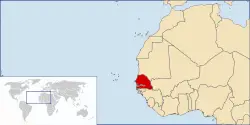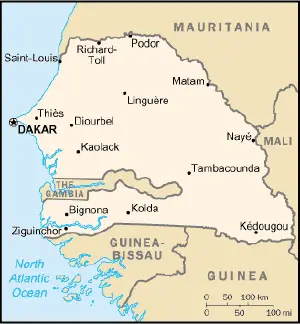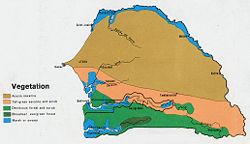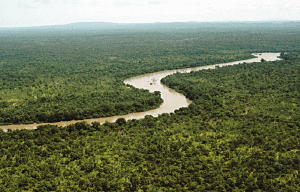Senegal
| République du Sénégal Republic of Senegal | |||||
| |||||
| Motto: "Un Peuple, Un But, Une Foi" (French) "One People, One Goal, One Faith" | |||||
| Anthem: Pincez Tous vos Koras, Frappez les Balafons | |||||
| Capital (and largest city) |
Dakar 14°40′N 17°25′W | ||||
| Official languages | French | ||||
|---|---|---|---|---|---|
| Government | Semi-presidential republic | ||||
| - President | Abdoulaye Wade | ||||
| - Prime Minister | Macky Sall | ||||
| Independence | |||||
| - from France | June 20 1960 France | ||||
| Area | |||||
| - Total | 196,723 km² (87th) 75,955 sq mi | ||||
| - Water (%) | 2.1 | ||||
| Population | |||||
| - 2005 estimate | 11,658,000 | ||||
| - Density | 59/km² 153/sq mi | ||||
| GDP (PPP) | 2005 estimate | ||||
| - Total | $20.504 billion | ||||
| - Per capita | $1,759 | ||||
| HDI (2004) | |||||
| Currency | CFA franc (XOF)
| ||||
| Time zone | UTC (UTC) | ||||
| Internet TLD | .sn | ||||
| Calling code | +221 | ||||
Senegal, officially the Republic of Senegal, is a country south of the Sénégal River in western Africa. It is one of only a handful of countries to have a near-enclave within its borders—the small nation of The Gambia, which penetrates more than 320 km into Senegal, from the Atlantic coast to the center of Senegal along the Gambia River, which bisects Senegal's territory. The area of Senegal south of The Gambia, known as the Casamance, has ample rainfall, in contrast to the dry lands to the north, and its distinctive people have a tradition of independence that led to a decades-long civil war only settled in 2004.
Senegal, though poor, has a tradition of political stability and peaceful transfers of power. It successfully made the transition from a one-party state to a multiparty democracy in 2000.
The former French colony was a major shipping point for the slave trade from Gorée Island.
Geography
Senegal is a coastal West African nation that is slightly smaller than Great Britain or the U.S. state of South Dakota. It is bounded by the Atlantic Ocean to the west, Mauritania to the north, Mali to the east, and Guinea and Guinea-Bissau to the south, both borders running along the Casamance River.
The Cape Verde islands lie some 560 kilometers (348 mi) off the Senegalese coast, but Cap Vert is a peninsula near Senegal's capital Dakar, and the westernmost point in Africa.
In total, Senegal has 2,640 km of land borders, and 531km of coastline and shoreline.
The lowest point in Senegal is the Atlantic Ocean, at sea level. The highest point is an unnamed feature near Nepen Diakha in the Fouta Djallon foothills at 1900 ft (581 m).
Terrain
Senegal has six vegetation zones: sahel, Sahel-Soudan, Soudan, Soudan-Guinea, tropical rainforest, and mangrove. The terrain is generally low, rolling, plains rising to foothills in the southeast. These lowlands are seasonally flooded but subject to periodic droughts.
Wildlife populations are threatened by poaching; other problems are deforestation, overgrazing, soil erosion, desertification, and overfishing.
Climate
The local climate is tropical with well-defined dry and humid seasons that result from northeast winter winds and southwest summer winds. The rainy season (May to November) has strong southeast winds, and the dry season (December to April) is dominated by the hot, dry, harmattan wind. Dakar's annual rainfall of about 24 in (600 mm) occurs between June and October when maximum temperatures average 80.6°F (27°C); December to February minimum temperatures are about 62.6°F (17°C). Temperatures inland are higher than along the coast, where the Canary Current keeps temperatures more moderate, and rainfall increases substantially farther south, exceeding 60 in (1.5 m) annually in some areas.
History
Archaeological findings throughout the area indicate that Senegal was inhabited in prehistoric times. Since then, Senegal has had a varied cultural history of kingdoms, brotherhoods and colonial struggles (between and against colonizing powers).
Eastern Senegal was once part of the Empire of Ghana. It was founded by the Tukulor in the middle valley of the Senegal River. Islam, the dominant religion in Senegal, first came to the region in the eleventh century. In the thirteenth and fourteenth centuries, the area came under the influence of the Mandingo empires to the east; the Jolof Empire of Senegal also was founded during this time.
Various European powers - Portugal, the Netherlands, and England - competed for trade in the area from the fifteenth century onward, until in 1677, France ended up in possession of what had become an important slave trade departure point - the infamous island of Gorée next to modern Dakar. It was only in the 1850s that the French began to expand their foothold onto the Senegalese mainland, at the expense of native kingdoms such as Waalo, Cayor, Baol, and Jolof.
In January 1959, Senegal and the French Sudan merged to form the Mali Federation, which became fully independent on June 20 1960, as a result of the independence and the transfer of power agreement signed with France on April 4 1960. Due to internal political difficulties, the Federation broke up on August 20. Senegal and Sudan (renamed the Republic of Mali) proclaimed independence. Léopold Senghor was elected Senegal's first president in September 1960.
After the breakup of the Mali Federation, President Senghor and Prime Minister Mamadou Dia governed together under a parliamentary system. In December 1962, their political rivalry led to an attempted coup by Prime Minister Dia. Although this was put down without bloodshed, Dia was arrested and imprisoned, and Senegal adopted a new constitution that consolidated the president's power. In 1980, President Senghor decided to retire from politics, and he handed power over in 1981 to his handpicked successor, Abdou Diouf.
Senegal joined with The Gambia to form the nominal confederation of Senegambia on February 1 1982. However, the union was dissolved in 1989. Despite peace talks, a southern separatist group in the Casamance region has clashed sporadically with government forces since 1982. Senegal has a long history of participating in international peacekeeping.[1]
Abdou Diouf was president between 1981 and 2000. He encouraged broader political participation, reduced government involvement in the economy, and widened Senegal's diplomatic engagements, particularly with other developing nations. Domestic politics on occasion spilled over into street violence, border tensions, and a violent separatist movement in the southern region of the Casamance. Nevertheless, Senegal's commitment to democracy and human rights strengthened. Diouf served four terms as president. In the presidential election of 2000, opposition leader Abdoulaye Wade defeated Diouf in an election deemed free and fair by international observers. Senegal experienced its second peaceful transition of power, and its first from one political party to another. On December 30, 2004 President Abdoulaye Wade signed a peace treaty with the separatist group in the Casamance region that was expected finally to end the 22-year-long rebellion, in which at least 3,500 people died, 50,000 refugees fled into The Gambia and Guinea-Bissau, and the region's once booming tourist economy virtually collapsed.
Government
Senegal is a republic with a powerful presidency; the president is elected every seven years, amended in 2001 to every five years, by universal adult suffrage. The current president is Abdoulaye Wade, reelected in March 2007.
Senegal has 65 political parties. The unicameral National Assembly has 120 members elected separately from the president. An independent judiciary also exists in Senegal. The nation's highest courts that deal with business issues are the constitutional council and the court of justice, members of which are named by the president.
Today Senegal has a democratic political culture, being one of the more successful post-colonial democratic transitions in Africa.
Local administrators are appointed by, and responsible to, the president.
Administrative divisions
Senegal is divided into 11 regions and subdivided into 34 departments, 94 arrondissements and multiple communes. The regions are:
|
|
|
|
Economy
In January 1994, Senegal undertook a bold and ambitious economic reform program with the support of the international donor community. This reform began with a 50 percent devaluation of Senegal's currency, the CFA franc, which was linked at a fixed rate to the former French franc and now to the euro. Government price controls and subsidies have been steadily dismantled. After seeing its economy contract by 2.1 percent in 1993, Senegal made an important turnaround, thanks to the reform program, with real growth in GDP averaging 5 percent annually during 1995-2001. Annual inflation had been pushed down to less than 1 percent, but rose to an estimated 3.3 percent in 2001. Investment rose steadily from 13.8 percent of GDP in 1993 to 16.5 percent in 1997.
The main industries include food processing, mining, cement, artificial fertilizer, chemicals, textiles, refining imported petroleum, and tourism. Exports include fish, chemicals, groundnuts, and calcium phosphate, and the principal foreign market is India, at 26.7 percent of exports (as of 1998).
As a member of the West African Economic and Monetary Union (WAEMU), Senegal is working toward greater regional integration with a unified external tariff. Senegal also realised full Internet connectivity in 1996, creating a miniboom in information technology-based services. Private activity now accounts for 82 percent of GDP. On the negative side, Senegal faces deep-seated urban problems of chronic unemployment, socioeconomic disparity, juvenile delinquency, and drug addiction.
Demographics
Senegal has a population of over 11 million, about 70 percent of whom live in rural areas. Density in these areas varies from about 77 km² in the west-central region to 2 km² in the arid eastern section.
Ethnicity
Senegal has a wide variety of ethnic groups and, as in most West African countries, several languages are widely spoken. The Wolof are the largest single ethnic group in Senegal at 43%; the Peuls and Toucouleur (also known as Halpulaar, Fulbe or Fula) (24%) are the second biggest group, followed by others that include the Serer (15%), Lebou (10%), Jola (4%), Mandinka (3%), Maures or Naarkajors, Soninke, Bassari and many smaller communities (9%). (See also the Bedick ethinc group.) About 50,000 Europeans (1%) (mostly French) as well as smaller numbers of Mauritanians and Lebanese reside in Senegal, mainly in the cities. Also located primarily in urban settings are the minority Vietnamese communities. From the time of earliest contact between Europeans and Africans along the coast of Senegal, particularly after the establishment of coastal trading posts during the fifteenth century, communities of mixed African and European (mostly French and Portuguese) origin have thrived. Cape Verdeans living in urban areas and in the Casamance region represent another recognized community of mixed African and European background. French is the official language, used regularly by a minority of Senegalese educated in a system styled upon the colonial-era schools of French origin (Koranic schools are even more popular, but Arabic is not widely spoken outside of this context of recitation). Most people also speak their own ethnic language while, especially in Dakar, Wolof is the lingua franca. Pulaar is spoken by the Peuls and Toucouleur. Portuguese Creole is a prominent minority language in Ziguinchor, regional capital of the Casamance, where some residents speak Kriol, primarily spoken in Guinea-Bissau. Cape Verdeans speak their native creole.
Religion
Islam is the predominant religion, practiced by approximately 94 percent of the country's population; the Christian community, at 4 percent of the population, includes Roman Catholics and diverse Protestant denominations. There is also a tiny minority who practice animism, particularly in the southeastern region of the country.
Islam
Islamic communities are generally organized around one of several Islamic Sufi orders or brotherhoods, headed by a khalif (xaliifa in Wolof, from Arabic khalīfa), who is usually a direct descendant of the group’s founder. The two largest and most prominent Sufi orders in Senegal are the Tijaniyya, whose largest sub-groups are based in the cities of Tivaouane and Kaolack, and the Murīdiyya (Murid), based in the city of Touba. The Halpulaar, a widespread ethnic group found along the Sahel from Chad to Senegal, representing 20 percent of the Senegalese population, were the first to be converted to Islam. The Halpulaar, composed of various Fula people groups, named Peuls and Toucouleurs in Senegal. Many of the Toucouleurs, or sedentary Halpulaar of the Senegal River Valley in the north, converted to Islam around a millennium ago and later contributed to Islam's propagation throughout Senegal. Most communities south of the Senegal River Valley, however, were not thoroughly Islamized until the nineteenth and early twentieth centuries. During the mid-nineteenth century, Islam became a banner of resistance against the traditional aristocracies and French colonialism, and Tijānī leaders Al-Hajj Umar Tall and Màbba Jaxu Ba established short-lived but influential Islamic states but were both killed in battle and their empires than annexed by the French.
The spread of formal Quranic school (called daara in Wolof) during the colonial period increased largely through the effort of the Tijaniyya. In Murid communities, which place more emphasis on the work ethic than on literary Quranic studies, the term daara often applies to work groups devoted to working for a religious leader. Other Islamic groups include the much older Qādiriyya order and the Senegalese Laayeen order, which is prominent among the coastal Lebu. Today, most Senegalese children study at daaras for several years, memorizing as much of the Qur'an as they can. Some of them continue their religious studies at informal Arabic schools (majlis) or at the growing number of private Arabic schools and publicly funded Franco-Arabic schools.
Christianity
Small Roman Catholic communities are mainly found in coastal Serer, Jola, Mankanya and Balant populations, and in eastern Senegal among the Bassari and Coniagui. In Dakar, Catholic and Protestant rites are also practiced by a portion of the Lebanese, Capeverdian, European, and American immigrant population, and among certain Africans of other countries. Although Islam is Senegal's majority religion, Senegal's first president, Léopold Sédar Senghor, was a Catholic Serer.
Other religions
Animism is the main other religion practiced. There are also small numbers of adherents of Judaism and Buddhism. Judaism is followed by members of several ethnic groups, while Buddhism is followed by a number of Vietnamese.
Culture
ReferencesISBN links support NWE through referral fees
- Berg, Elizabeth. 1999. Senegal. Tarrytown, NT: Marshall Cavendish. ISBN 076140872X.
- Cutter, Charles. 2006. Africa, 41st edition. Harpers Ferry, WV: Stryker-Post Publications. ISBN 1887985727
External links
- Government
- (French) Gouvernement du Sénégal - Official governmental website
- Embassy of the Republic of Senegal in London government information and links
- (French) Observatoire sur les systèmes d'information, réseaux et inforoutes
- News
- (French) Senegal news
- allAfrica.com - Senegal news headline links
- SenActu - Senegal news headline links
- Overviews
- BBC News Country Profile - Senegal
- CIA World Factbook - Senegal
- MSN encarta Senegal overview
- Encyclopaedia Britannica's Country Page - "Senegal"
- [2]
- Photos
- African Photos - Senegal Hundreds of photos from around Senegal
- Maps
- Literature
- Music
- Cora Connection West African music resources
- Tourism
- Practical information on Senegal with maps, culture, articles ...
- Guided Tours of Senegal
- The Lonely Planet travel guide on Senegal
- Ethnicity
- (French) Senegals ethnic groups (in french)
- Other
- (French) L'Afrique - Sénégal Hundreds of photographs and articles
- Senegal shows tolerant face of Islam ...
- Movement of the Democratic Force of Casamance
Credits
New World Encyclopedia writers and editors rewrote and completed the Wikipedia article in accordance with New World Encyclopedia standards. This article abides by terms of the Creative Commons CC-by-sa 3.0 License (CC-by-sa), which may be used and disseminated with proper attribution. Credit is due under the terms of this license that can reference both the New World Encyclopedia contributors and the selfless volunteer contributors of the Wikimedia Foundation. To cite this article click here for a list of acceptable citing formats.The history of earlier contributions by wikipedians is accessible to researchers here:
The history of this article since it was imported to New World Encyclopedia:
Note: Some restrictions may apply to use of individual images which are separately licensed.








